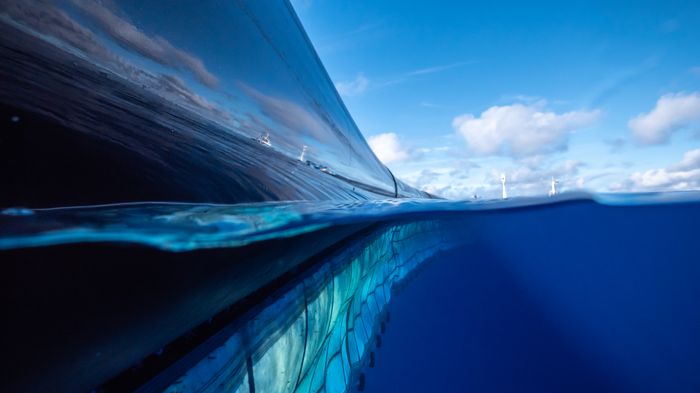
System 001 Learnings – Root Causes Summarized
Back to updatesIn September, we launched our first system, with the aim of achieving proof of technology and commencing cleanup. Twenty years after the discovery of the Great Pacific Garbage Patch, this was the first time a system was deployed to start to clean it up. We did this after completing hundreds of scale model tests and a series of nearshore prototypes.
Yet, when launching the system, we knew, and had to accept, that uncertainty remained. This makes sense, as something like this has never been done before. Especially when considering the interaction between the system and the plastic, there was no way to test it before deploying a cleanup system in the Great Pacific Garbage Patch. Hence, we must learn by doing, developing the technology in an iterative fashion.
During the first four months that the system was offshore, we were able to confirm many of the key features of the cleanup system. We also encountered some unscheduled learning opportunities; notably 1) the system hasn’t been able to retain the plastic it caught, and 2) the floater suffered from a structural failure, causing an 18-meter end section to disconnect from the rest of the system, just before the end of 2018.
Following the structural failure, we decided to bring the system back to land as quickly as possible, where we began an intensive root cause analysis process. Over the past two months, we collected as much data as possible and analyzed it with the purpose of understanding what caused the two known problems. Since understanding a problem is half the solution, this root cause analysis forms the crucial basis for upgrading the design before the relaunch in the coming months. In this post we’ll explain the results of this analysis.
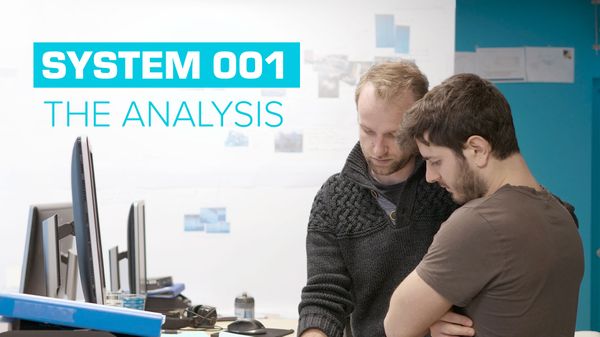
BUT FIRST, THE SUCCESSES
Once System 001 was launched into the Pacific, we first deployed it 300 nautical miles offshore as a dress rehearsal, before going all the way to the center of the Great Pacific Garbage Patch. When the system passed the checklist, we decided to tow it the remaining distance.
In the four months that System 001 was in the Pacific, many aspects of the technology were validated; namely:
– The U-shape configuration (and the system’s ability to retain the U-shape). Once the system was arranged in its operational shape, it maintained this configuration without any challenges.
– System 001’s ability to orient with the wind. To be able to effectively catch plastic, the concave side of the system must always point in the direction the system travels (relative to the plastic). Hence, we designed the system to be able to passively orient itself away from the wind. We have been able to confirm that the system indeed expresses this self-orienting behavior.
– Plastic concentrations in and around the system were much higher than in any other location in the Great Pacific Garbage Patch; and, although the periods the plastic was retained in the system were not yet of sufficient length, the system did capture and concentrate plastic.
– Due to the heterogeneity of ocean conditions, System 001 was built to follow the varying movements of the water, rather than respond against the forces. The system’s stability in operational configuration and response to following the waves were in line with our design expectations.
– Plastic was not witnessed to have been lost due to overtopping.
– During its time offshore, the electronics and the satellite connection were strong, allowing us to compile data on its movements, to measure the strains on the floater and to acquire imagery taken from the system. As the cleanup fleet will one day be fully autonomous, being able to establish a reliable communications link with the systems is crucial.
– Protecting the natural environment is at the core of our work. On board, the three crew shifts were marine biologists and third-party observers to understand if and how System 001 interacted with the environment surrounding it. During its deployment, no environmental impact issues were observed.
RETAINING THE PLASTIC
Once the system was deployed and configured in the Great Pacific Garbage Patch, it was soon observed that the plastic that had accumulated within the system was not remaining inside of it. At times, large amounts of plastic would gather, only for some -or all- of it to float out again. Plastic was also occasionally observed to accumulate on the convex side of the cleanup system. The plastic count within the system did not remain high enough for an efficient extraction process. It is important to mention that, when we have a fleet of systems deployed, the ability of the systems to retain debris for several weeks or even months is crucial, since that will be the expected timeframe between collection trips. To effectively remove vast amounts of plastic, we, therefore, needed to understand why the plastic wasn’t being retained.

During the design process of the system, The Ocean Cleanup’s engineers performed extensive numerical simulations and tests to be able to predict the system’s behavior in the patch. However, for several reasons, there is some uncertainty in these predictions. Firstly, the vertical velocity profile of winds just above the water surface, in between waves, is relatively unknown. For most structures at sea, the wind velocities at this low height above the water are not very relevant and it is difficult to measure locally all over the ocean – creating a lack of need and feasibility to acquire these measurements. The same holds for the current speed in the upper half-meter of the water, where most plastics reside. Due to these uncertainties, the relative speed difference between the system and the plastic is hard to accurately estimate; and our experience in the patch further proves that our models did not manage to predict it well enough. Lastly, the wave-drift forces that propel the system forward are hard to forecast, due to the system’s long, flexible floater – thus, requiring some assumptions and simplifications for the numerical simulations.
When it became apparent that System 001 was not retaining plastic, we initially came up with 27 possible hypotheses that could potentially impact the motions of plastic relative to the system. These hypotheses generally fell into two groups: 1) possible explanations for the system to move too slow relative to the plastic, and 2) possible ways in which the system could influence local water dynamics that interfere with the movement of the plastic. Using GPS-enabled drifters, we simulated the path of the ocean plastic. During these tests, we did observe the drifters floating into the system and subsequently floating out.
Here’s the trajectory of one of the GPS buoys in the cleanup system pic.twitter.com/m50J4OXnS9
— Boyan Slat (@BoyanSlat) November 21, 2018
We then took all the data that we had acquired from the drifter tests, the electronic pods on System 001, and the AutoNaut unmanned surface vessel, and began filing and analyzing the data. We created new models with this data and compared this to our previous models. It was apparent that our assumptions of these forces had indeed been underestimated and the force balance on the system and the plastics are different than we expected. We also realized that the surface transport is higher and plastic moves faster in the direction of the wind than we initially projected. Not only was the system then moving too slow, but the plastic was also moving faster than we had predicted.
The evidence was enough for us to conclude that the relative speed differential between the plastic and the system occasionally shifts from positive to negative. For the system to effectively retain plastic, it must consistently travel faster than the plastic; in other words, it must go faster. With this understanding, we can apply modifications that target this issue specifically.
STRUCTURAL FAILURE
On December 29th, our third shift crew was alerted to an 18-meter section detached from the full system. While this unscheduled learning opportunity was easier to identify, we still conducted a thorough investigation to find the root cause, approaching the problem from both the structural and hydrodynamic points of view.
From a structural perspective, we wanted to determine if we missed anything in the concentration of stresses, local overloading, or if we had missed anything on the stresses inside the material. The team initially speculated that the structural breakdown could be traced to the stabilizers. Located at ten points on the system, two were connected to the 18-meter section that had detached. Without complete access to the system in the initial days following the breakage, the team conjectured that the heavy stabilizer frames exerted too much force on the extremities (a hydrodynamic issue).
A structural analysis would confirm that there were additional stresses indicated in the same locations as the stabilizers, but they did not exceed the capacity of the material – therefore, we could rule out that the stabilizers could be the main cause for the break.
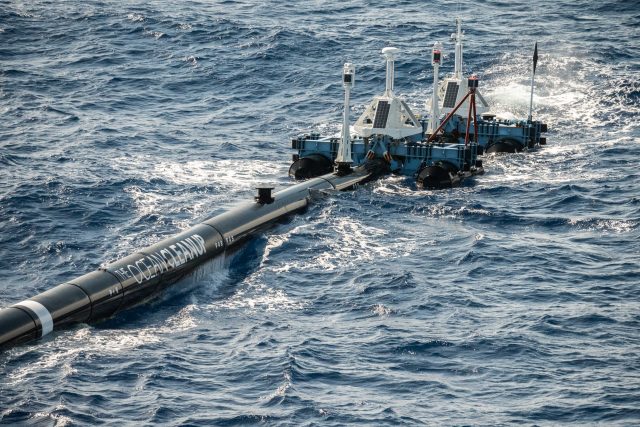
The team then began analyzing the dovetail connection (the connector between the HDPE pipe and the screen). Because the dovetails were welded in one-meter segments, due to the fabrication possibilities of our supplier, this created a discontinuity, or gaps, between each weld. These gaps yielded stress concentrations and it was exactly at one of these welds that the fracture occurred. Had it not been for the weld beads that filled the gaps between two dovetail sections, the cause of the fracture might have been obvious from the outset.
Although these beads filled the gaps, they did not form a structurally high-quality bond with the pipe, which formed stress concentrations directly next to these weld beads.
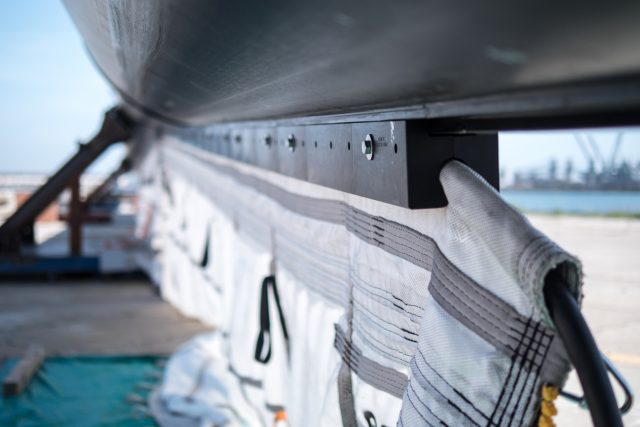

After performing a visual inspection in Hawaii, it was much more apparent that the structural malfunction originated at the dovetail welds. An underwater photo of the break showed concentric rings that would increase up through the HDPE pipe, indicating that a fatigue fracture had propagated from an initial crack located between two welds for the dovetail, which could have only resulted from this aspect of the design.
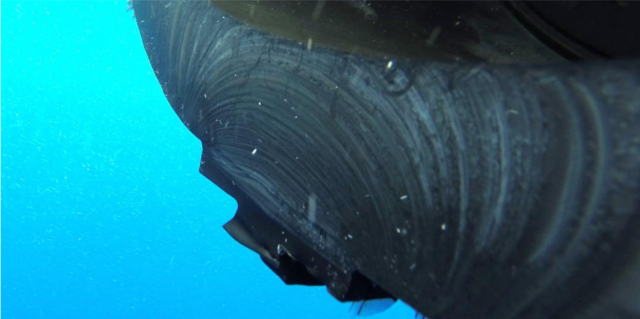
By cross-checking numerical results with the strain gauge data, we observed the same order of magnitude for these observed deformations as could be derived from the ring pattern of the fracture surface.
Due to the discontinuity in the dovetail, a stress concentration was formed in the floater wall (carrying roughly twice the stresses compared to the nominal stress in the floater) causing crack initiation under the influence of cyclical loading, severely reducing the fatigue life of the HDPE floater. Additionally, because of the increased motion on the end sections, which was exacerbated by the mass of the stabilizers and their frames, the cracks in the pipe gradually increased and eventually caused this section to suddenly and rapidly detach.
Together with a team of external experts, that included HDPE pipe and component suppliers, university professors, research institutes and other consultants, this was enough evidence for us to conclude that a failure in the design and manufacturing of this connection caused the fracture in the system. Hence, it is essential that we eliminate the causes of these localized stresses on the floater before relaunch.
WHAT’S NEXT
The problem of ocean plastic is getting worse by the day, so it is crucial that we get System 001 operational as soon as possible, after which we can start the scale-up. The engineering team is using these conclusions and results to update the design and prepare for relaunch.
Using this thorough understanding, we hope to resolve the issues that are known to us and prove our technology, but we do realize that there may still be more unidentified challenges ahead. Only further proving the importance of returning to the patch as soon as possible, so we can continue to learn from and optimize the technology.
Moving forward, we successfully demobilized System 001 in Hilo Bay (Hawaii, Big Island) on March 23, 2019. After ample considerations and many calculations, we decided that it is more cost effective to prepare for relaunch from the mainland, than upgrade and relaunch from Hawaii. We now have all hands on deck and we aim to be ready for relaunch within a matter of months.

